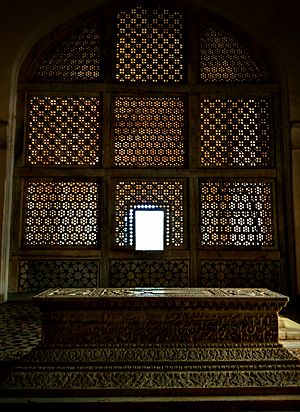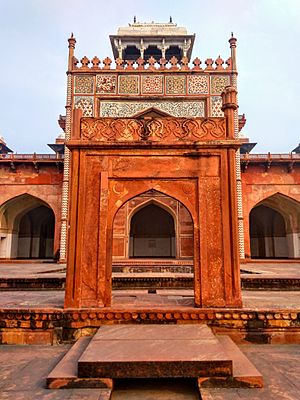Akbar's tomb facts for kids
Akbar's tomb is the special resting place of Akbar, a famous Mughal emperor. His son, Jahangir, built it between 1605 and 1613. The tomb is located on a large piece of land, about 119 acres, in a place called Sikandra. This area is a suburb of Agra in Uttar Pradesh, India.
Contents
Where is Akbar's Tomb Located?
Akbar's tomb is in Sikandra, a part of Agra. It's on the Mathura road, about 8 kilometers (5 miles) west of the city center. Not far from the tomb, about 1 kilometer away, is the Tomb of Mariam-uz-Zamani. She was Akbar's favorite wife. After Akbar passed away, she created a big garden around his tomb. Later, her son Jahangir buried her there too.
History of Akbar's Tomb

After Emperor Akbar died, his son Jahangir took over the building project. He finished the tomb between 1605 and 1613. It cost about 1,500,000 rupees back then and took around 3 or 4 years to build. Akbar's wife, Mariam-uz-Zamani, also helped by creating a large garden around the tomb.
Later, during the time of Emperor Aurangzeb, some groups caused trouble. The tomb was damaged, and valuable items like gold, jewels, and carpets were taken.
Much later, in the early 1900s, George Curzon, who was in charge of India at the time, made sure the tomb was repaired. These big repairs finished in 1905. Curzon wanted to show respect for the past and make the beautiful building new again for the future.
Architecture of Akbar's Tomb
The main entrance to the tomb is through the south gate. This gate is the biggest one. It has four tall, white marble towers called chhatris at the top. These towers are similar to the ones you can see at the Taj Mahal, but they were built even earlier!
The tomb itself is inside a walled area that is 105 meters (344 feet) square. The main tomb building looks like a pyramid with four levels. On top, there's a marble room with a "false tomb." This is just a monument. The real grave, like in many old tombs, is actually in the basement below.
The buildings are mostly made from a deep red sandstone. White marble is used for special decorations. You can see beautiful patterns made from these stones and black slate on the tomb and the main gate. These patterns include geometric shapes, flowers, and fancy writing. They show a style that became even more detailed in later buildings like Itmad-ud-Daulah's tomb.
Gallery
-
Circumferential gallery around the cenotaph
See also
 In Spanish: Tumba de Akbar para niños
In Spanish: Tumba de Akbar para niños
- Akbar
- Akbarnama
- Tomb of Mariam-uz-Zamani, tomb of the chief queen consort of Akbar
- Tomb of Jahangir, tomb of Akbar's successor
- Humayun's Tomb, tomb of Akbar's father
- Bagh-e Babur, tomb of Akbar's grandfather


















